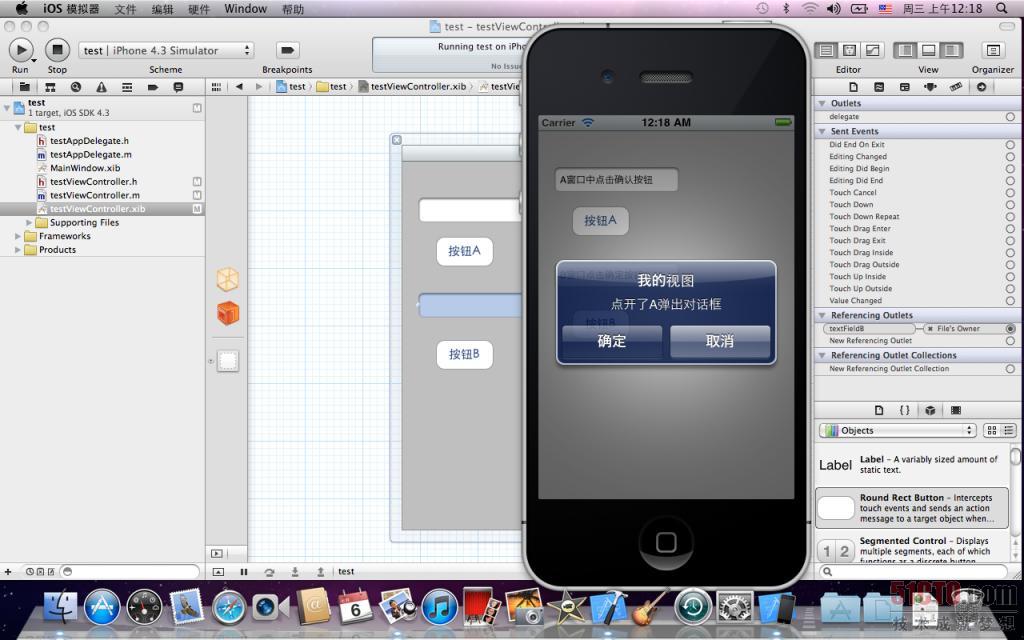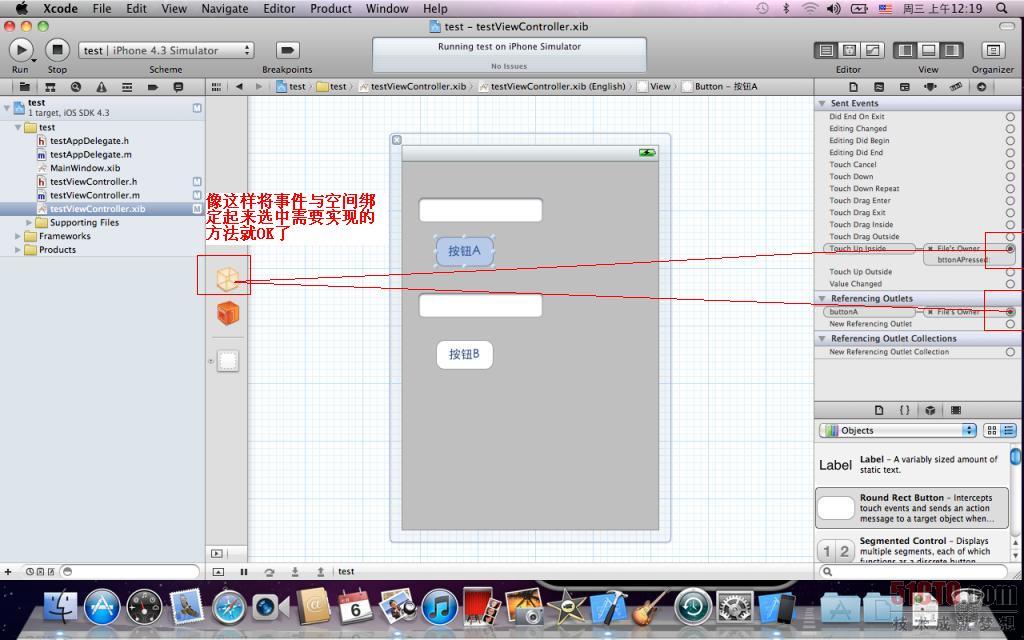iPhone教程 對話框與輸入框按鈕響應界面
iPhone教程 對話框與輸入框按鈕響應界面是本文要介紹的內容,主要來介紹一下iphone中UIButton 與UITextField簡單的界面彈出對話框以及按鈕的響應 。項目需求:實現兩個按鈕 ,兩個文本框點擊按鈕在文本輸入框中顯示從那個按鈕中點進去的信息。如圖:

聲明類
- //
- // testViewController.h
- // test
- //
- // Created by 宣雨松 on 11-7-5.
- // Copyright 2011年 __MyCompanyName__. All rights reserved.
- //
- #import <UIKit/UIKit.h>
- // 在ViewController中實現UIAlertViewDelegate接口 用來監聽彈出框 確定與取消
- @interface testViewController : UIViewController <UIAlertViewDelegate>
- {
- //定義了一個按鈕buttonA
- IBOutlet UIButton *buttonA;
- //定義了一個文本框A
- IBOutlet UITextField *textFieldA;
- //定義了一個按鈕buttonB
- IBOutlet UIButton *buttonB;
- //定義了一個文本框B
- IBOutlet UITextField *textFieldB;
- }
- //聲明A按鈕被按下的一個方法(IBAction) 相當于(void)
- -(IBAction)bttonAPressed:(id)text;
- //聲明B按鈕被按下的一個方法
- -(IBAction)bttonBPressed:(id)text;
- //注意這兩個方法是用來綁定在空間上 稍后我給大家介紹如何綁定
- @end
接下來我介紹一下控件與方法的綁定 比如我須要點擊按鈕A 后調用我自己寫的方法 bttonApressed() 我需要點中按鈕后 右側出現視圖欄 點中 New Referencing Outlet 拉出一條線拖到 左側上***個菱形上后 選 buttonA 表示這個butonA 與代碼中聲明的buttonA關聯上了 然后在點中Touch Up Inside 拉出一條線 依然拖動到左側***個菱形上選擇bttonAPressed()方法 這表示點擊按鈕buttonA后 會調用自己寫的方法 bttonAPressed() 簡單吧 。 Android 開發的可視化布局卻是不如IPHONE開發的布局,J2ME 就更不行了。如圖:

實現類
- //
- // testViewController.m
- // test
- //
- // Created by 宣雨松 on 11-7-5.
- // Copyright 2011年 __MyCompanyName__. All rights reserved.
- //
- #import "testViewController.h"
- @implementation testViewController
- - (void)dealloc
- {
- [super dealloc];
- }
- - (void)didReceiveMemoryWarning
- {
- // Releases the view if it doesn't have a superview.
- [super didReceiveMemoryWarning];
- // Release any cached data, images, etc that aren't in use.
- }
- #pragma mark - View lifecycle
- /*
- // Implement viewDidLoad to do additional setup after loading the view, typically from a nib.
- - (void)viewDidLoad
- {
- [super viewDidLoad]
- }
- */
- UIAlertView * alertA;
- - (void)bttonAPressed:(id)text
- {
- //在這里實現了按鈕A綁定的方法
- //這里說一下nil 這個東西就好比java 語言中的 null
- alertA= [[UIAlertView alloc] initWithTitle:@"我的視圖" message:@"點開了A彈出對話框"
- delegate:self cancelButtonTitle:@"確定" otherButtonTitles: nil];
- //objectiveC開發中調用方法是用"[]" 例如: [alertA addButtonWithTitle:@"取消"];
- //如果是為方法賦值則類似java 對象.成員 例如 :textFieldA.text
- //添加了一個取消按鈕
- [alertA addButtonWithTitle:@"取消"];
- //將這個UIAlerView 顯示出來
- [alertA show];
- //objective-C 不像java 有自己的垃圾回收機制 所以我們在編寫程序中一定要注意釋放內存 從一開始就養成良好習慣
- [alertA release];
- }
- UIAlertView * alertB;
- -(void)bttonBPressed:(id)text
- {
- //在這里實現了按鈕B綁定方法
- alertB = [[UIAlertView alloc] initWithTitle:@"我的視圖" message:@"點開了B彈出對話框"
- delegate:self cancelButtonTitle:@"確定" otherButtonTitles: nil];
- [alertB show];
- [alertB release];
- }
- - (void)alertView:(UIAlertView *)alertView clickedButtonAtIndex:(NSInteger)buttonIndex
- {
- //在這里添加對話框按鈕響應事件 根據不同窗口判斷
- if(alertView == alertA)
- {
- switch (buttonIndex)
- {
- case 0:
- textFieldA.text = @"A窗口中點擊確認按鈕";
- break;
- case 1:
- textFieldA.text = @"A窗口點擊取消按鈕";
- default:
- break;
- }
- }else if (alertView == alertB)
- {
- textFieldB.text = @"B窗口點擊確定按鈕";
- }
- }
- - (void)viewDidUnload
- {
- [super viewDidUnload];
- // Release any retained subviews of the main view.
- // e.g. self.myOutlet = nil;
- }
- - (BOOL)shouldAutorotateToInterfaceOrientation:(UIInterfaceOrientation)interfaceOrientation
- {
- // Return YES for supported orientations
- return (interfaceOrientation == UIInterfaceOrientationPortrait);
- }
- @end
小結:iPhone教程 對話框與輸入框按鈕響應界面的內容介紹我那了,希望本文對你有所幫助。
本文轉自 http://blog.csdn.net/xys289187120/article/details/6586961--


























